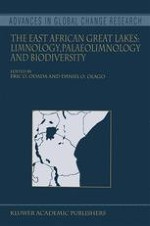2002 | OriginalPaper | Buchkapitel
Vegetation Changes and Their Climatic Implications for the Lake Victoria Region during the Late Holocene
verfasst von : Immaculate Ssemmanda, Annie Vincens
Erschienen in: The East African Great Lakes: Limnology, Palaeolimnology and Biodiversity
Verlag: Springer Netherlands
Enthalten in: Professional Book Archive
Aktivieren Sie unsere intelligente Suche, um passende Fachinhalte oder Patente zu finden.
Wählen Sie Textabschnitte aus um mit Künstlicher Intelligenz passenden Patente zu finden. powered by
Markieren Sie Textabschnitte, um KI-gestützt weitere passende Inhalte zu finden. powered by
The pollen sequence of the core V95-2P (00°58.67’ S, 33°27.32’ E, 67 m depth) from Lake Victoria mirrors larger extension of forests between ca 6500 and ca. 4100 yr BP, implying a wetter climatic conditions than during the later period. Highest humidity was experienced in the region prior to ca. 6500 yr BP, before the semi-deciduous forest formations became widespread in the region. From ca. 5000 yr BP, the forests around Lake Victoria were mainly of semidecideous character with increasing abundance of celtis associated with Noloptelea grandis, mixed with some Guineo-Congolian elements such as Tetrorchidium The period ca. 4100 to ca. 3000 yr BP shows a progressive decline of the semideciduous forest formations and the establishment of open vegetation with Capparidaceae and Gramineae attesting to a dry climate. After ca. 3000 yr BP, the pollen data particulary that from high altitude, evidence an amelioration of climate. The dry montane forest with Podocarpus and Juniperus procera underwent significant extension which reached a maximum at ca. 1700 yr BP. At low altitude, the extension of the semideciduous forests in relation to this improvement of climate, is evidenced mainly until ca. 2200 yr BP. During this sub-humid climatic phase, either the amount of precipitation was inadequate or the dry season was too long for a large development of evergreen forests in the Lake Victoria region. Pollen data from this core and from the other cores in the region indicates that the increase in rainfall during this period was larger and lasted for a longer duration in the high altitude sites than at low altitude. From ca. 1700 yr BP, the significant decrease in the abundance of the pollen of the regional taxa indicates a decline of the Juniperus-Podocarpus dry montane forest or a reduction in precipitation at high altitude. During this dry period, both the montane and the semideciduous forests decline at the profit of the open grass dominated formations: open woodlands and probably savannas.
